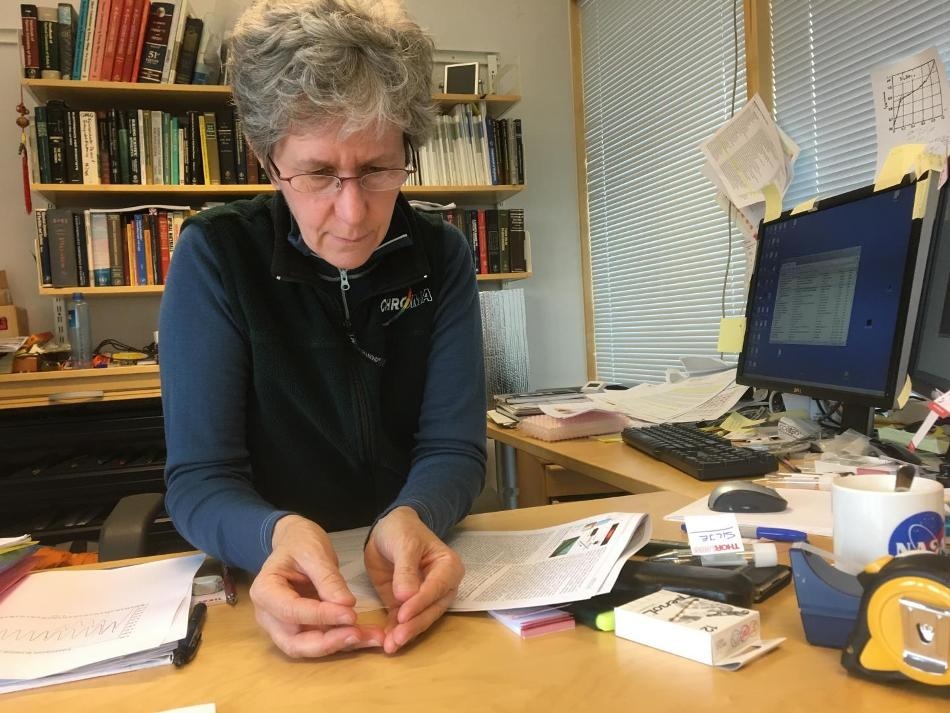Oct 26 2016
 Ursula Gibson, a professor of physics at the Norwegian University of Science and Technology, holds a glass fiber with a semiconductor core. Rapid heating and cooling of this kind of fiber allows the researchers to make functional materials with applications beyond traditional fiber optics. (Credit - Nancy Bazilchuk)
Ursula Gibson, a professor of physics at the Norwegian University of Science and Technology, holds a glass fiber with a semiconductor core. Rapid heating and cooling of this kind of fiber allows the researchers to make functional materials with applications beyond traditional fiber optics. (Credit - Nancy Bazilchuk)
Glass fibers are used in numerous applications - from connecting people to the internet to enabling keyhole surgery by supplying light via medical devices such as endoscopes. Although today's fiber optics is versatile, scientists globally are eager to broaden their capabilities by incorporating semiconductor core materials to the glass fibers.
A team of researchers have developed glass fibers possessing single-crystal silicon-germanium cores. The method used to create these could help to develop high-speed semiconductor devices and broaden the capabilities of endoscopes says Ursula Gibson, a physics professor at the Norwegian University of Science and Technology and senior author of the paper.
"This paper lays the groundwork for future devices in several areas," Gibson said, because the germanium in the silicon core enables researchers to locally modify its physical properties.
The article, "Laser recrystallization and inscription of compositional microstructures in crystalline SiGe-core fibres," was published on October 24 in Nature Communications.
Melting and Recrystallizing
To understand what the researchers accomplished, it has to be recognized that germanium and silicon have varying melting points. When the two substances are integrated in a glass fiber, flecks of germanium-rich material are dispersed across the fiber in a chaotic fashion as the silicon has a higher melting point and tends to solidify, or "freeze" first. These germanium flecks restrict the ability of the fiber to convey information or light.
"When they are first made, these fibers don't look very good," Gibson said.
However, quickly heating the fiber by exposing it to a laser beam enabled the team to melt the semiconductors in the core in a controlled manner. Using the difference in the solidification behavior, the team could manipulate the local concentration of the germanium within the fiber based upon where they aimed the laser beam and for what duration.
If we take a fiber and melt the core without moving it, we can accumulate small germanium-rich droplets into a melt zone, which is then the last thing to crystalize when we remove the laser slowly. We can make stripes, dots... you could use this to make a series of structures that would allow you to detect and manipulate light.
Ursula Gibson, Physics Professor, Norwegian University of Science and Technology
A remarkable structure was created when the researchers periodically disrupted the laser beam as it moved through the silicon-germanium fiber. This produced a series of germanium-rich stripes spanning the width of the 150-micrometer diameter core. That kind of pattern produces what is referred to as a Bragg grating, which could assist in expanding the capability of long wavelength light-guiding devices.
"That is of interest to the medical imaging industry," Gibson said.
Rapid Heating, Cooling Key
Another main characteristic of the laser heating and geometry of the silicon-germanium fiber is that after heating the fiber, it can also be cooled very quickly as the fiber is moved away from the laser on a moving stage.
Controlled fast cooling allows the mixture to solidify into a single uniform crystal - the length of the fiber - which makes it suitable for optical transmission. Earlier, scientists dealing with bulk silicon-germanium alloys have had issues in building a uniform crystal that is an excellent mix, because they have not had adequate control of the sample’s temperature profile.
When you perform overall heating and cooling, you get uneven composition through the structure, because the last part to freeze concentrates excess germanium. We have shown we can create single crystalline silicon-germanium at high production rates when we have a large temperature gradient and a controlled growth direction.
Ursula Gibson, Physics Professor, Norwegian University of Science and Technology
Transistors that Switch Faster
Gibson says the laser heating method could also be applied to simplify the adding of silicon-germanium alloys into transistor circuits.
"You could adapt the laser treatment to thin films of the alloy in integrated circuits," she said.
Conventionally, Gibson said, electronics researchers have studied other materials, such as gallium arsenide, in their search to construct much faster transistors. However, the blend of silicon and germanium, frequently referred to as SiGe, allows electrons to travel via the material more rapidly than they travel via pure silicon, and is well-suited with standard integrated circuit processing.
"SiGe allows you to make transistors that switch faster" than silicon-based transistors used currently, she said, "and our results could impact their production."